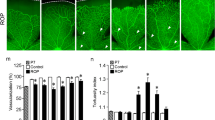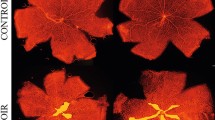Abstract
This work is dedicated to proving our hypothesis that catecholamines and their metabolites play a crucial role in the development of retinopathy of prematurity, which leads to progressive uncontrollable vascularization in the retina, leading to blindness. The study was performed in an animal model of retinopathy of prematurity, which was achieved by hyperoxygenation in rats on postnatal days 7, 14, 21, and 30. The content of catecholamines and their metabolites in the retina of rats was determined by high performance liquid chromatography with electrochemical detection. It was shown that, in the rats with retinopathy, the content of L-DOPA on days 21 and 30 was decreased as compared to the control, whereas the content of noradrenaline on day 14 life increased compared to the control. However, we did not observe changes in the content of dopamine in the experimental animals relative to the control in any period studied. Given the published data on the involvement of catecholamines in the regulation of vasculogenesis in the retina in normal state, our data on the changes in the catecholamine metabolism in the retina in the model of retinopathy of prematurity can be regarded as evidence of the important role of catecholamines in the pathogenesis of this severe disease.


Similar content being viewed by others
REFERENCES
Chakroborty, D., Sarkar, C., Yu, H., et al., Proc. Natl. Acad. Sci. U. S. A., 2011, vol. 108, no. 51, pp. 20730–20735. https://doi.org/10.1073/pnas.1108696108
Moreno-Smith, M., Lutgendorf, S.K., and Sood, A.K., Future Oncol., 2010, vol. 6, no. 12, pp. 1863–1881.
Dvorak, H.F., J. Thromb. Haemost., 2005, vol. 3, no. 8, pp. 1835–1842.
Hadjiconstantinou, M. and Neff, N.H., Life Sci., 1984, vol. 35, no. 11, pp. 1135–1147.
Katargina, L.A., Khoroshilova-Maslova, I.P., Maibogin, A.M., et al., Mezhd.Zh. Prikl. Fundam. Issled., 2017, vol. 3, pp. 190–194.
6. Witkovsky, P., Arango Gonzalez, B., Haycock, J.W., et al., J. Comp. Neurol., 2005, vol. 481, no. 4, pp. 352–362.
Spix, N.J., Liu, L.L., Zhang, Z., et al., Invest. Ophthalmol. Vis. Sci., 2016, vol. 57, no. 7, pp. 3047–3057.
Zhang, N., Favazza, T.L., Baglieri, A.M., et al., Invest. Ophthalmol. Vis. Sci., 2013, vol. 54, no. 13, pp. 8275–8284.
Lopez, V.M., Decatur, C.L., Stamer, W.D., et al., PLoS Biol., 2008, vol. 6, no. 9, p. 236.
Falk, T., Congrove, N.R., Zhang, S., et al., J. Biomed. Biotechnol., 2012, vol. 2012.
Dal, MonteM., Cammalleri, M., Mattei, E., et al., Invest. Ophthalmol. Vis. Sci., 2015, vol. 56, no. 1, pp. 59–73.
Makhoul, I.R., Peleg, O., Miller, B., et al., Arch. Dis. Child., 2013, vol. 98, pp. 565–567.
Shelke, R.R., Lakshmana, M.K., Ramamohan, Y., et al., Int. J. Dev. Neurosci., 1997, vol. 15, no. 1, pp. 139–143.
Funding
This study was performed under the state assignment for the implementation of research, development, and technological work (R&D) (state registration nos. 0108-2019-0006 and AAAA-A18-118032390091-7).
Author information
Authors and Affiliations
Corresponding author
Ethics declarations
Conflict of interests. The authors declare that they have no conflict of interest.
Statement on the welfare of animals. All manipulations with animals were performed in accordance with the protocol approved by the Bioethics Commission of the Koltzov Institute of Developmental Biology, Russian Academy of Sciences and Helmholtz Institute of Ophthalmology in compliance with national and international requirements.
Additional information
Translated by M. Batrukova
Rights and permissions
About this article
Cite this article
Katargina, L.A., Osipova, N.A., Panova, A.Y. et al. The Role of Catecholamines in the Development of Pathological Retina Neovascularization in an Experimental Model of Retinopathy of Prematurity in Rats. Dokl Biochem Biophys 489, 373–376 (2019). https://doi.org/10.1134/S160767291906005X
Received:
Published:
Issue Date:
DOI: https://doi.org/10.1134/S160767291906005X




